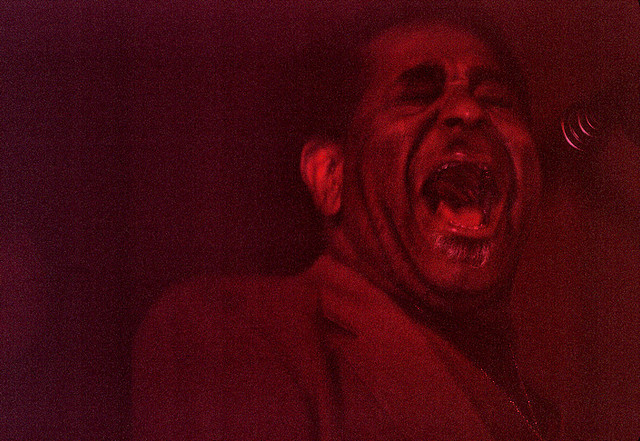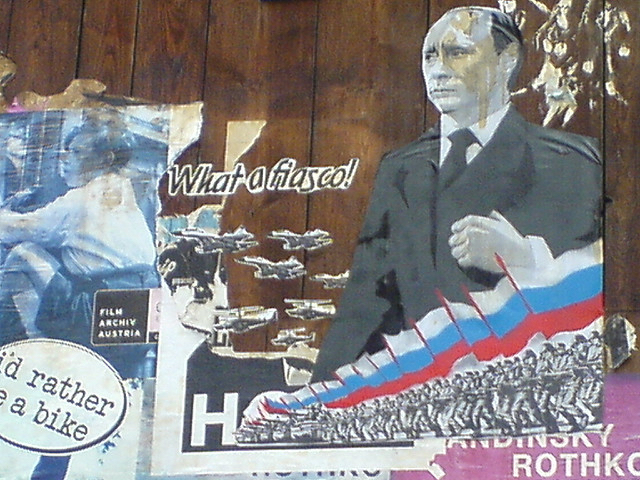It’s taken as a truism that “foreigners” love America. They just don’t particularly like the US. That is, American cultural exports are often popular the world over, even in places where the United States isn’t popular. Acutely aware of this disjuncture, Washington has often sought to use cultural diplomacy to close this gap, pitching its movies and music in order to win over its critics.
In Satchmo Blows Up the World, Penny Von Eschen chronicles Cold War-era efforts to use jazz, in order to promote America abroad – with the dual aim of deflecting communist racial polemics by making African-American artists visible, and trying to help fan the flames of dissent culture in the Soviet bloc. There was, it seems, also the bonus of promoting an American art form distinct from ‘Old World’ idoms like classical music. Jazz had the intended effect of upsetting foreign authorities (during the late 1940s, trombone and jazz record ownership in the USSR was criminalized), and thrilling audiences in the Eastern Bloc, and nonaligned states, such as the former Yugoslavia.
However, despite the good feelings it engendered towards American culture, there was little correlation between the music and musicians and, say, the question of ICBM deployment. It also couldn’t fully cover up the fact that non-white musicians were not often treated as equals back home, which is the sort of hypocrisy Von Eschen reserves the bulk of her criticism for. Jazz ambassadors like Dizzie Gillespie (see the first photo) and Louie Armstrong helped cover up this inequality, by projecting images of a post-racial America that did not exist. Which was of course advantageous given how readily other countries could denounce Jim Crow. Interracial five-man (and woman) bands touring the Near East were not as Potemkin as simultaneous Soviet cultural efforts, but the message was clear. The musicians ended up showcasing an ideal that their sponsors in Washington, like Ike, did not necessarily desire to see implemented in the United States.
Perhaps the most important issue discussed by Von Eschen is how the artists themselves felt about the “culture” they were promoting – who were they representing? What were they representing? Their art form, themselves, a vaguely defined “Americana”, anti-communism, racial integration, the International Brotherhood of Musicmakers? In practice, they were almost never, to a man or woman, the patsies that Langley and Foggy Bottom might have hoped for, and many enjoyed a fair amount of autonomy while on tour (including indulging in criticism of US foreign policy.) Interestingly, the government-funded projects weren’t attacked on budget lines, since the Cold War appeared to make such efforts necessary. After all, the Soviets were aggressively trying to portray themselves as progressive internationalists rising above petty nationalisms and creeds.
When reports came out years later in Ramparts magazine over how deeply involved US intelligence had been in cultural diplomacy, new generations of artists and students were appalled. Wasn’t jazz supposed to be the avant-garde music of the left? Still-living participants were unruffled in contrast: they had done what they felt was right. Both wide-eyed idealists and jaded covert operatives could come to sincerely believe that “cultural” operations would pave the way for “liberation” in countries under or threatened by Communist rule. Hungarian émigrés on Radio Free Europe’s airwaves, like the ones whose work and that of other 1950s Eastern European exiles is described in Wilford Hugh’s Mighty Wurlizter and Peter Grose’s Operation Rollback, sincerely believed their work would help rollback communism, a motivation sharpened by thoughts of friends and family “left behind” in the country.

These foreign nationals who became propagandists were also hardly bought-and-paid-for agents of influence, though quite a few turned out to be little more than greedy opportunists and egoists. Those who showed a bit more seriousness and ideological commitment ended up working very closely with American true believers, hailing in equal numbers from trade union offices, faculty lounges, and literary salons. Many the musicians’ agency controllers (the more sympathetic ones at least) did not see their work as “propaganda” – they simply, and truly, believed in the message they were spreading.
These cultural warriors’ main patron, CIA Director of Plans Frank Wisner, was such a true believer in the official talk of the “rollback” agenda that he went into an alcohol-fueled depressive tailspin after the 1956 uprising failed. Eventually, he threw in the towel altogether once someone sat him down and told him that “rollback” was really just a rhetorical device for winning over Democratic voters in Milwaukee and Omaha. Others, especially émigrés for whom the likelihood of ever returning home lessened with each passing year of Communist rule, became similarly disillusioned over time. Wisner’s own inner struggle was punctuated by a tragic conclusion: compelled to retire early and in increasingly poor health, he committed suicide in 1965, the ghosts of Hungary never far from his mind (though it is worth noting that his efforts in Guatemala and Iran didn’t elicit nearly the same response.) Many of the “true believers” that went on the cultural missions gave into similar resignation.

A good many of the project’s unresolved tensions are present today among the promoters and artists in hip-hop diplomacy, the successor to the jazz-led propaganda projects of the 1950s and 1960s. It is interesting that the same sort of mistrust and dislike of jazz among those artists’ official handlers is present with respect to hip-hop. It is also interesting that Islamic hip hop seems to provoke negative reactions among American audiences, who, though cognizant of the Islamic strains in the idiom, are far less receptive than Muslim Europeans, and Arabs. It’s also harder to pitch Islamic hip-hop because of the tendency, in American government circles, to attack Islam, as a whole. Moving to distinguish, however clumsily, the good from the bad, appears disingenuous, and qualified. Jazz was a more universally accepted genre.
This is not a new problem for the architects of these infinitives. During the Cold War, the FBI was very distrustful of the “dissent” culture that was associated with some of these cultural expressions at home. Many agents also had a moral opposition to jazz, feeling as though “Negro music” essentially implied “drugs and crime.” These private reservations clashed sharply with the message that the “jambassadors” were supposed to promote. But then, that was about par for the course. The CIA, in-between recruiting former Nazis and sending saboteurs into the Eastern bloc, nonetheless found time to underwrite an animated production of George Owell’s Animal Farm (1954) and disseminate the prize-winning works of Boris Pasternak in English. The KGB, of course, was no better: underwriting pan-European youth festivals on the one hand, and throwing Soviet conscientious objectors into psychiatric wards on the other.
It will be interesting to see what the new hip hop jambassadors will achieve, and whether they will ultimately be considered a success (which vaguely implies that the original jambassadors achieved something tangible.) There does not seem to be an elaborate logic to the program. It mainly seems to be about “deradicalization” if WikiLeaks documents are to be believed, which is much more specific than jazz promotion at its height. The current program also happens to be trickier, considering that some popular artists speak out against US domestic and foreign policy. Generally, it appears that this effort will not be successful, for these reasons, and also the fact that tracks without explicit associations with America in their lyrics are not going to affect listeners’ attitudes about the country. After all, this is not the 1950s. The United States has far less goodwill than ever. It will take a lot more than good music to change Muslim hearts and minds about the country.
Photographs courtesy of fs999, Tomislav Mavrovic, and US Embassy New Delhi. Published under a Creative Commons license.





